My US Nationals Experience in Salina, Kansas
By Luke Penner, CFI, Harv's Air, Manitoba, EAA 1062750
November 2019 - Ahead of me lay a full week of competitive aerobatic flying among 85 pilots from the United States and nearly a dozen other countries. What could be better?
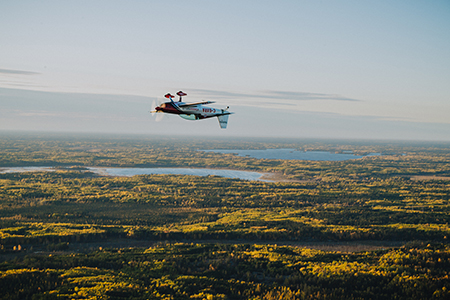
The author. Photo credit Jacob Oldenkamp.
My name is Luke Penner, and I am the chief flight instructor at Harv's Air in Manitoba. I have been flying for more than 16 years, the last four of which I've been competing in aerobatics.
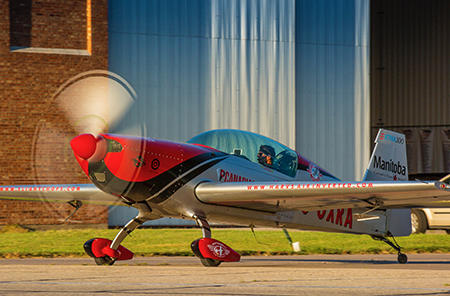
Luke Penner and his Extra 300 getting ready to depart for the Known flight. Photo credit Leigh Hubner.
I fly a two-place Extra 300L monoplane, and this is my first year competing in the Advanced category. I had started my first year in Sportsman, and the two years that followed in Intermediate.
After decades of being held at the North Texas Regional Airport (KGYI), and two years being held at Wittman Regional Airport (KOSH) in Oshkosh, Wisconsin, the decision-makers at the International Aerobatic Club decided the 2019 U.S. National Aerobatic Championships would take place in the geographical center of the country in Salina, Kansas.
The Format
Each competitor flies three different sequences: the Known sequence (published well before the contest season begins), Freestyle sequence (can be designed by the pilot in an effort to capitalize on pilot skill and airplane capability), and the Unknown sequence (given to the pilots the day before and cannot be practiced).
Pilots competing in Primary and Sportsman do not fly an Unknown sequence. The format for Advanced and Unlimited is a little different at U.S. Nationals, in that we fly a Free Unknown sequence, but more on that later!
Part of the fun (and stress) of competing in aerobatics is simply flying cross-country to get to the contest locations. I flew more than 5,000 nm this season in C-GXRA, an Extra 300L owned and operated by Harv's Air in Manitoba. As far as aerobatic airplanes go, the 300L is a great cross-country airplane featuring two hours of endurance at around 170 knots true airspeed. However, my favorite practical feature of the airplane has to be its second seat, which has allowed my wife to come along to contests and training events with me. We've become quite proficient at cramming only mission-critical gear into the turtledeck of the Extra. This includes heels and a sundress.
After the four-hour cross-country flight from my hometown of Steinbach, Manitoba, I touched down on the 12,301-foot main runway in Salina, Kansas. Upon shutting down at Hangar 606, an enormous World War II-era building, my fourth U.S. Nationals experience began how they always do: like a family reunion.
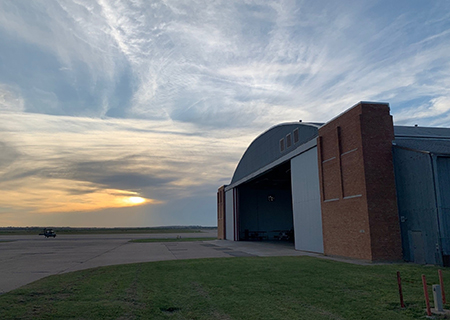
Hangar 606, the headquarters for U.S. Nationals operations.
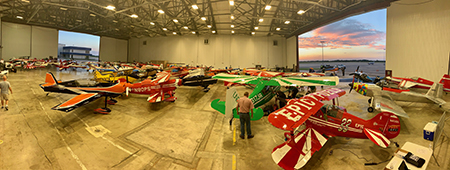
Inside Hangar 606, brimming with aerobatic hopefuls at sunset.
I was immediately greeted by friends that I see only at aerobatic events, which reminded me of something the contest director of the 2016 Nationals, Gary Debaun, told me: "It's the people that are the best part of this sport." I couldn't agree more, based on how warm, welcoming, and helpful everyone has been to me as I have grown and developed in the sport.
With the contest starting on Saturday, September 21, I arrived a couple days early to get settled and to fly a practice flight in the aerobatic box on Friday.
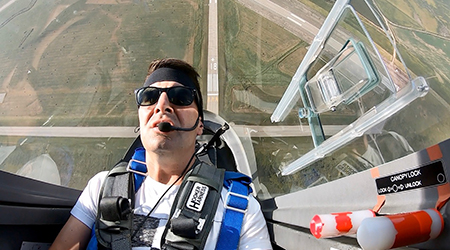
Pulling up just past center box.
Most pilots got only a single 10-minute practice slot due to the high number of other pilots. I flew my practice flight with my coach, Aaron McCartan, who gave me live commentary from the ground via radio.
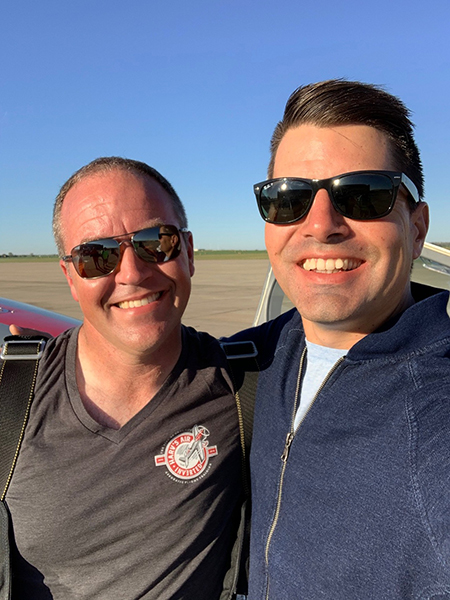
With my coach, Aaron McCartan. Aaron was finishing off his first season competing in Unlimited.
I did a couple run-throughs of the Known sequence, making sure that my GoPro cameras were running so I could review the footage later and study all the geographic references in and around the box. I wasn't happy with the exits on my downline 3/4 snap-rolls due to some potentially confusing references in the box, so after reflying the third one, I heard the box master come over the box frequency to tell me my time was up. After returning for landing, I hung out at the airport to watch friends fly their practice flights and enjoyed being in the presence of so many great aerobatic pilots, and to check out their beautiful airplanes, too!
The next day, all the pilots and volunteers squeezed into a fairly small room on the second floor of Hangar 606 for the opening ceremonies. Immediately following was the Sportsman/Primary flight briefing, which I was a part of as an assistant judge. IAC contests rely completely on volunteers.
This was the largest group of all, with 35 pilots flying, so I settled in for nearly five hours out on the judging line in 31-degree-Celsius heat. After the first round of flying concluded, I retired to my hotel to study the next day's weather, particularly the upper wind forecast. On the floor of my hotel room, I used tape to mark up a rudimentary box, including the pertinent landmarks and reference points that I would be looking for when actually flying the sequence. Things happen quickly when moving through the box at 300 feet per second, so pre-visualization is crucial.
Flight 1, Known Sequence
Before each flight, there is a mandatory briefing to attend. If a pilot is late for a briefing, they are penalized a certain number of points or they must pay a small fine. The order of flight is randomized for each flight. As a result, each pilot is always crossing their fingers that they won't be the first to fly. If you do, you have to fly for "cold judges" and you are the "wind dummy" and don't have the perceived advantage to observe other pilots' flights.
I drew position 13 out of 20 pilots to fly, so I sighed a bit out of momentary relief. As the Advanced group began flying, I moved GXRA out of the hangar to the startup area, where I sat with the airplane in the shade until a vehicle carrying our starter — Gary, the person who coordinates with the chief judge about when to launch competitors — parked next to me. He told me to get strapped in the airplane, reminding me of the frequencies in use and the holding procedures around the box. And with that, plus a tinge of anxiety, I started up the Extra’s 300-hp Lycoming engine and taxied out for departure.
Once airborne, and after clearance from Salina tower, I switched to box frequency and remained silent, as you do not speak unless spoken to on box frequency to ensure the competitor flying their sequence in the box is not distracted. After what felt like 30 minutes, but in actuality was only about five minutes of orbiting in the hold at 4,000 feet, I heard a crackle on the radio and then the chief judge’s voice saying, "Luke Penner, chief judge." "Luke Penner," I replied. "Luke, the box is yours; have a good flight." I acknowledged with a thank-you and began to get set up for my entry into the box. It's always in these moments when my nerves want to get the best of me, so I tried to calm myself as I positioned for a perfect box entry, which should be thought of as being Figure 0. As I dove in and accelerated to 200 knots, I aggressively rocked my wings to 90 degrees of bank, three times, which signified the start of my sequence to the seven judges down below.
Now level and in position, I pulled into Figure 1, which was a bow tie figure, and for the next four minutes the world completely disappeared and my singular focus was to fly these nine figures exactly as I had planned to on the ground in my imaginary box. Four minutes went by, and once again, I rocked my wings three times, this time to signify the completion of my sequence.
After I landed and started taxiing back to the hangar, many thoughts ran through my mind. "Was the radius on the half-outside-loop on Figure 2 concentric? Did the half-snap on Figure 5 show enough pitch? Did I stay inside the eastern boundary of the box during the outside rolling turn?" As I shut the airplane down by Hangar 606 and opened the canopy, my friend Justin was on hand with an ice-cold water bottle, which hits the spot after an intense few minutes of pulling +8g and pushing -6g. Feeling satisfied that I had executed my plan and being quite certain that I didn't get any dreaded HZs, or hard zeros, I watched the rest of the Advanced group fly. By the day's end, the scores were posted online, and I was elated to see that I had won a bronze medal for the flight. I was over the moon.
Flight 2, Freestyle Sequence
The next day it was right back to business with the second flight: the Freestyle. In the hours before the flight, my time is punctuated with polishing the Extra, walking my sequence, and trying my best to ignore the anxiety gremlins. With upper winds coming from the opposite direction versus the previous day, I was ready to dive into the box towards the south and go to work.
Unlike during the first flight, as soon as I pulled hard into the vertical half-roll of Figure 1, I was able to silence the aforementioned gremlins and was able to both execute my plan and enjoy the experience more. After I finished my sequence, a smile was on my face, and I thought, "I'm flying Advanced at the U.S. Nationals; I can't believe it!" As I turned final to land, an enormous feeling of gratitude came over me towards the people who support and encourage me to participate in this sport. I exited the runway and once again waited to see how the scores turned out. I was very happy to see that after the last pilot landed, I was sitting in second overall. However, I knew that it was an extremely close race and that my greatest challenge was two days away in my third and final flight, the Free Unknown.
Flight 3, Free Unknown Sequence
This is unlike a regional contest, where the third sequence for Advanced would be an Unknown. The format at the U.S. Nationals for the third flight follows the one used by CIVA seen at European and world-level contests. This was a brand-new experience for me, about which I was excited and nervous at the same time. The top 10 pilots after the Known sequence meet in the evening after the Freestyle sequence to propose 10 figures, which will then be used to construct multiple sequences that each pilot can choose to fly in the end.
After the first two pilots finished writing their chosen figures on a whiteboard during the figure selection meeting, it was my turn to submit a figure of my own. Since I love snap-rolls, I submitted a one-and-a-half snap-roll into an opposite-direction 2-of-4 roll into a half-outside-loop down. Once the 10th and final figure was submitted and accepted by the committee, a large group of us Advanced pilots headed to the restaurant in the hotel to begin putting these figures together, along with any four "connector figures" to make a cohesive sequence. The next morning, 10 sequences were posted for each pilot to choose from.
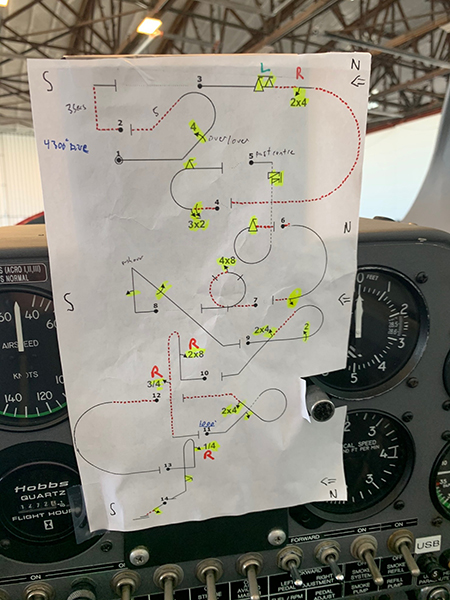
My sequence card for the Free Unknown.
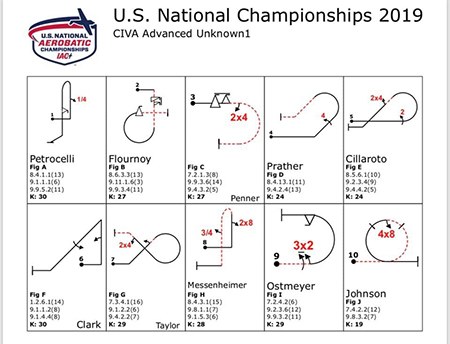
The 10 submitted figures for the Free Unknown.
After some consideration, I chose Sequence Alpha, informed the administrators of this, and began memorizing it. I recorded a voice memo of myself talking through each figure in order, then went for a 10-kilometer run around Salina, playing the voice memo back to myself over and over until it was ingrained in my mind and the nerves were shaken off. The next day I woke up early to get my mind right and to visualize the flight based on the wind conditions I was anticipating.
During the briefing, the chief judge confirmed my suspected official wind direction, and I drew sixth to fly in the order of flight, which I was happy about. However, my happiness was short-lived as all of us were thrown a curveball less than 30 minutes before the first pilot was to take off: Due to the box crosswind limit being exceeded, the official wind direction was changed 90 degrees from what we had all planned. The unified grumbling of the Advanced pilots in the hangar confirmed this, and before long, a last-minute briefing was held to go over the procedures, since this particular box direction hadn't been used thus far in the contest.
Now, instead of a 25-knot crosswind, I had to compensate all my figures for a 25-knot headwind. The silver lining was that I was too busy re-visualizing and planning my flight to even notice that I had any anxiety. Before long, I was orbiting up at 4,000 feet, waiting to dive in and fly my first Free Unknown sequence. Of all the 10 submitted figures, there was only one that I had never flown before. It was submitted by a veteran Advanced pilot, Steve Johnson. It is an outside/inside loop with a 4-of-8 roll entered at the top of the loop. I knew that if I could cleanly get past this figure, which was right in the middle of my sequence, I would be through the trickiest part.
I dove into the box, pulled level at 200 knots and remembered the words my friend Justin Hickson had told me before my flight: "Just take it one figure at a time." So rather than worry about that outside/inside loop, I instead gave each figure 100 percent focus, until four-and-a-half minutes later I wagged my wings three times and switched back to tower to come in to land in Salina for the last time in this contest. Hours, which felt like days, went by, and after hitting refresh on my phone for the umpteenth time, I finally saw that I had finished third overall at my first U.S. Nationals in the Advanced category. Happiness overcame me.
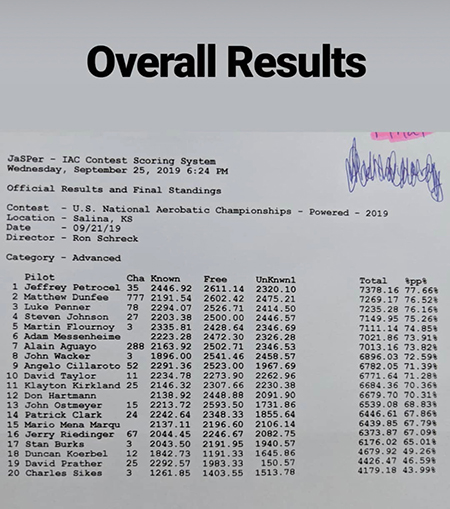
The overall results after the last flight.
The rest of my week in Salina was significantly more relaxing.
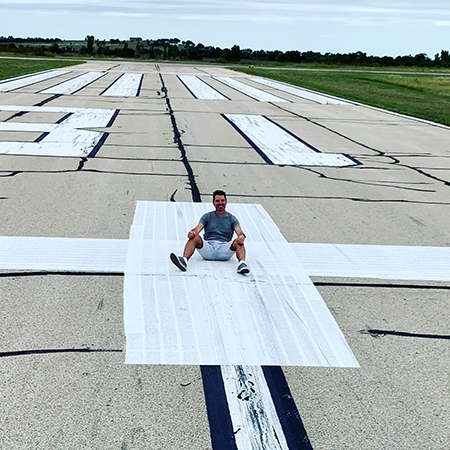
Hanging out on the center box marker after volunteering as a boundary judge.
On the penultimate day, I volunteered as a boundary judge for the final Unlimited flight, which is often regarded as the best seat in the house. Radio in hand, I watched some of my heroes, such as Rob Holland and Aaron McCartan, fly incredibly complex sequences. At the same time, I called out to the chief judge over the radio anytime a pilot would go out of the box. Of all the Unlimited pilots, Rob was the only pilot to not go out. There is a reason he has won the U.S. Unlimited title nine consecutive times.
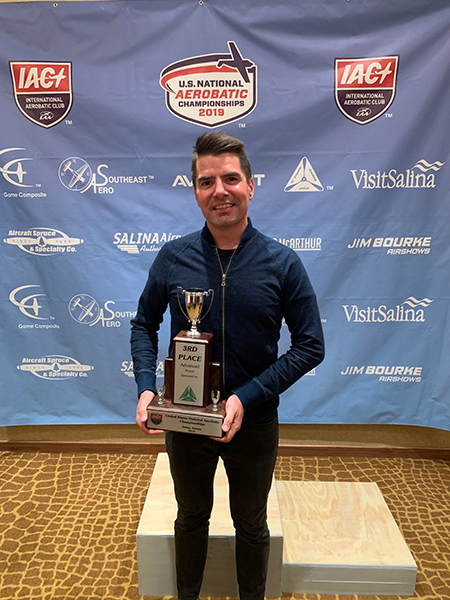
The big smile and a third-place trophy.
Friday night brought the awards banquet, and before I knew it, I was headed home to Manitoba after a challenging and unforgettable week in Kansas. Now I can't wait until next year!
